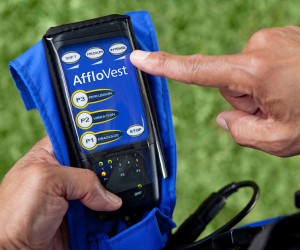Clinical Study Details Pulmonary Function Improvement in 5 CF Patients Using AffloVest

 AffloVest, a wearable, self-contained oscillation vest device from International Biophysics that helps patients with Cystic Fibrosis breathe easier, was previously backed by numerous patient testimonies and is now proven in a new Clinical Study that it increased forced expiratory volume in one second (FEV1) an average of 11.5%. Five adolescent patients, all of whom had cystic fibrosis, used the AffloVest for three to five months each and saw an average FEV1 flow increase of 312 cc’s.
AffloVest, a wearable, self-contained oscillation vest device from International Biophysics that helps patients with Cystic Fibrosis breathe easier, was previously backed by numerous patient testimonies and is now proven in a new Clinical Study that it increased forced expiratory volume in one second (FEV1) an average of 11.5%. Five adolescent patients, all of whom had cystic fibrosis, used the AffloVest for three to five months each and saw an average FEV1 flow increase of 312 cc’s.
Michael Cooper, a respiratory therapist in the Chicago, Illinois, who specializes in the care and treatment of cystic fibrosis patients, developed and executed this study entitled “An Evidence-based Study of Adolescents with Cystic Fibrosis Demonstrated that AffloVest® by International Biophysics Contributed to Improved Lung Function Scores” at a Medical Center actively treating cystic fibrosis patients. His patients had all been using an older technology air bladder with a loud air generator high frequency chest wall oscillation (HFCWO) vest as part of their prescribed treatment plan before switching to the new technology, battery powered, quiet AffloVest. “The objective of this study was to measure lung function scores before and after use to determine efficacy,” wrote Cooper in the study. The study describes forced vital capacity (FVC), FEV1, and forced expiratory flow (FEF) before and after treatment with AffloVest. All five patients demonstrated improvements in all three measured categories, and furthermore, the patients reported increased compliance in their treatments.
The youngest patients were two males, aged 14 years. According to the study, the mother of one stated, “[My] son is much more motivated to use his vest due to ease of use and freedom of movement during treatment.” This boy achieved the highest change in FEV1 (18.8% increase) and FEF (63.7%). The other boy achieved the highest change in FVC (14.9% increase) and was second in FEV1 and FEF increases (17.3% and 23.8%, respectively). His mother indicated that he enjoys wearing the AffloVest, especially since it allows him to play basketball better than before.
[adrotate group=”1″]
Slightly older adolescents also benefited from AffloVest. A 15-year-old female exhibited acceptable and repeatable spirometry data, achieving an increase in FVC of 5.5%, FEV1 of 3.0%, and FEF of 3.5%. She is now better able to complete dance exercises after wearing the AffloVest. The two oldest patients, an 18-year-old male and female, rounded out the group. The female patient is on the verge of entering college and will bring the AffloVest with her to her school. According to the study, she indicated, “[I have] been using it more frequently to comply with treatment plans.” The male patient echoed the increased usage of AffloVest and stated that it is helping him play sports. They achieved increases in FVC of 9.5% and 7.3%, FEV1 of 7.7% and 10.2%, and FEF of 2.2% and 16.6%, respectively.
“This Clinical Study is the first in the USA to document what we have all heard from our patients; the Afflovest works, really works,” said Bob Ellis, Vice President of Sales and Marketing at International Biophysics, in a communication with Cystic Fibrosis News Today. “With approaching 1,000 Afflovest in use in the USA and over 1,000 in Europe, we now have a clinical study to document its efficacy. I know this will help get more physicians to start prescribing for this game-changer of a product and treatment.”
Download the clinical study here: Afflovest Cystic Fibrosis Clinical Study
This clinical case study was not commissioned by Afflovest® or its parent company International Biophysics Corporation. The clinician involved developed this study and collected the clinical information on his own. All patients independently obtained an AffloVest by prescription from their physicians via their own insurance or private pay for their own personal use. Results were documented during routine clinical visits.







